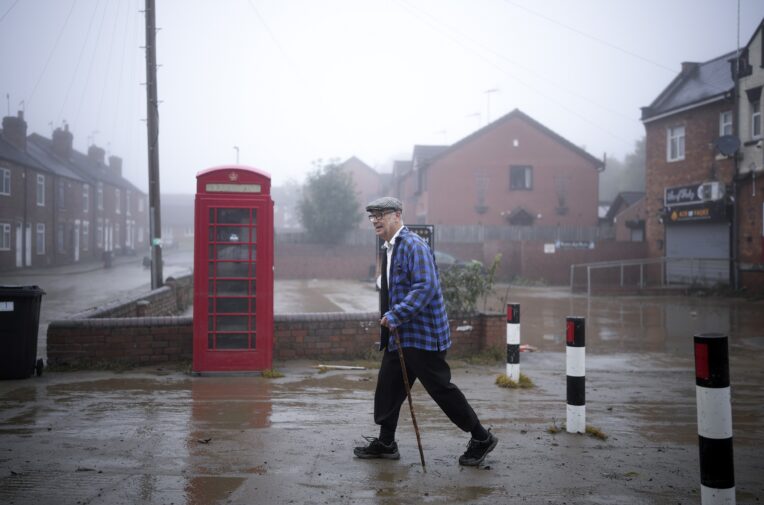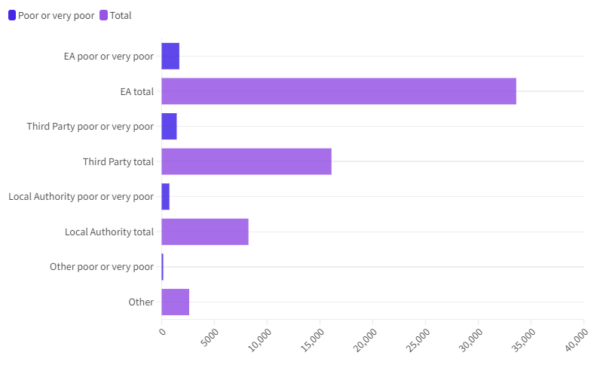
Residents view the aftermath of flooding in the village of Catcliffe, South Yorkshire. 6% of the county’s flood defences were in poor condition last year. Photo: Christopher Furlong/Getty Images
Thousands of England’s flood defences were in poor condition before storms hit
New analysis of Environment Agency data shows over 4,000 crucial flood defences in sub–par condition
Thousands of England’s flood defences were in poor condition before storms hit
New analysis of Environment Agency data shows over 4,000 crucial flood defences in sub–par condition
Residents view the aftermath of flooding in the village of Catcliffe, South Yorkshire. 6% of the county’s flood defences were in poor condition last year. Photo: Christopher Furlong/Getty Images
More than 4,000 of England’s vital flood defences were rated as poor or very poor in inspections carried out by the Environment Agency.
These defences range from flood walls and embankments to outfall pipes and culverts. They protect property and lives in some of England’s most at–risk towns and cities, including areas affected by Storm Babet.
The findings will add to growing scrutiny of the way the EA deals with flood risk. After the damage caused by Storm Babet, MPs have called for a review of the agency’s failings, stating that some of their constituents only received flood warnings when their homes were already flooded.
Steve Reed, Labour’s shadow environment secretary, in response to Unearthed’s findings, said: “The Conservatives’ sticking-plaster approach to flooding has left communities devastated and cost the economy billions of pounds”.
Of England’s 64,000 “high consequence” flood defences, 4,200 were rated as either condition 4, meaning poor, or 5, meaning very poor, in 2022. This means that 7% of the country’s most important flood defences are deemed to be in a poor state, according to data obtained under freedom of information rules. Nearly 900 of the defences – 1.3% of the total – were judged to be in very poor condition.
Only 3% of all England’s high consequence defences were deemed “very good” or condition 1 last year, while a third were classed “good”. The majority – 57% – were rated “fair”.
The EA told Unearthed that it routinely inspects flood defences and when there is danger of a flood, emergency repairs are carried out. It clarified that when an asset is below the required condition, it does not necessarily mean that it has structurally failed, or that performance in a flood is compromised.
A spokesperson for the EA said the agency had invested £200 million between April 2022 and March 2023 “to ensure our assets were winter ready.”
While the majority of England’s vital flood defences are maintained by the EA, over a quarter are privately owned and maintained by unnamed “third parties”. The data shows that privately owned defences are nearly twice as likely to be in poor condition: 1,500 of privately owned defences – 9% of the total – were in a poor or very poor condition last year, compared with just 5% of assets maintained by the EA.
Unearthed has previously reported there is little oversight over privately owned defences, with some local authorities not knowing who owns them and the EA lacking powers to compel owners to properly look after them.

Parts of the East Midlands, Yorkshire, Suffolk and Lincolnshire experienced record rainfall for October as Storm Babet caused flooding across England, Wales, and Scotland.
In South Yorkshire, where people were warned not to travel unless necessary and flooding caused damage to 165 homes, 6% of all the county’s 1,400 high consequence defences were in condition 4 or 5, while 11% of its privately maintained assets were in these bottom grades. In Sheffield, 8% of the city’s 666 high consequence defences, including 14% of its 273 privately owned assets, were in poor or very poor condition.
On one street in Nottingham, residents complained of sewage flowing down the road and having to try to stop it coming into their homes, as the city was hit by flooding last week. One in 10 of the city’s 309 high consequence flood assets are rated as poor or very poor. Across Nottinghamshire as a whole, 6% of all assets were in a poor condition, with one in six of the county’s privately maintained defences graded as poor or very poor.
In Chesterfield, Derbyshire, where Maureen Gilbert, 83, died after her home was flooded, four of the town’s 58 crucial flood defences were rated poor or very poor. Just over one in eight of England’s high consequence flood defences are maintained by local authorities and 9% of these assets – 774 in total – were in category 4 or 5 condition.
The EA maintains just over half of the high consequence flood defences across England. 4% of these were rated poor and less than 1% of EA maintained assets rated very poor.
Increased flooding is one of the main risks England faces from climate change. Flood damage across the UK currently causes £700m of damage a year, according to the Association of British Insurers. Earlier this year, researchers estimated that could rise by a fifth if global warming continues.

